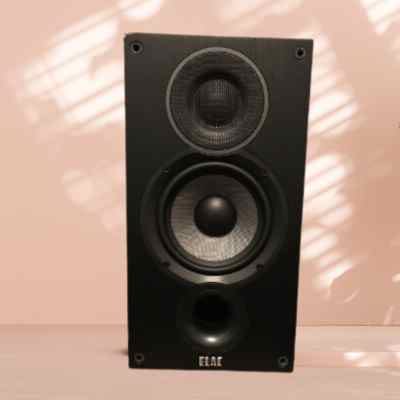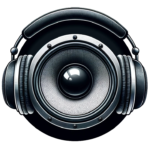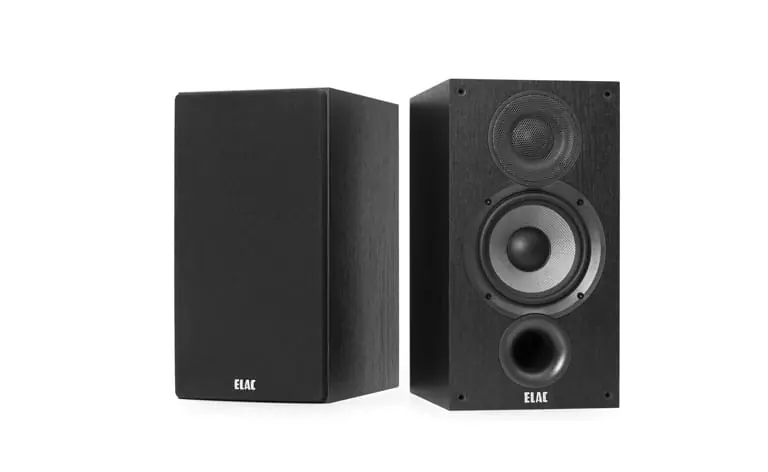ELAC Debut 2.0 B5.2 Shelf Speakers Review
First Impressions
When I first received the ELAC Debut 2.0 B5.2 Bookshelf Speakers from Amazon, my initial thought was the size. These were bigger than the Micca MB42 speakers I was used to for my desktop computer. The matte black finish gives them a classic, sleek look, although I do wish there were options for warmer colors or wood finishes. The weight of the speakers was noticeable, hinting at the solid build quality. The speakers were impressive in size and weight, forming a hefty presence in any setting.
Sound Quality
The first time I tested these speakers, I was struck by the crispness and clarity of the sound they produced. I would describe the sound as leaning toward bright, with a sparkle to the overall room acoustics. I did notice that they tended to be bright when it came to high frequencies. However, I was able to correct this quality by adjusting the treble on my receiver.
The mid-range clarity of these speakers is impressive. The neutrality of the speakers allowed me to easily distinguish between different instruments and vocals in various compositions whether it be rock, pop, jazz, classical, or folk music. I could tell where each instrument or vocal was coming from, creating an immersive listening experience.
The low-end performance came as a pleasant surprise. Despite their compact size, these ELACs delivered a bass response to reckon with. The bass was tight, robust, and natural sounding even without a subwoofer.
The imaging and soundstage that these speakers provide are much better than average at this price point. With decent placement, these speakers were able to project a sound stage wider than themselves. However, for the best results, they need to be placed straight forward in a room as towing them in improves imaging.
Performance with Different Amps and DACs
I tried these speakers with different amps and DACs, and the results were consistently good. The quality of the sound varied slightly depending on the type of amp or DAC that was used, but this only highlighted the versatility of these speakers and their ability to adapt according to the input. The speakers performed quite well with a Fosi Audio T3 as well as a Rotel A10. They also worked well with the NAD C316 Bee V2, which is a warmer more forgiving amp.

Audiophile Sound and Value
If you’re looking for an audiophile experience at a reasonable price, then these speakers deliver without question. They render a balance of highs and lows that is pleasurable and not fatiguing. In addition, off-axis, they are also pleasant. Therefore, even if you’re not sitting right in the sweet spot, you still get to enjoy great sound.
The Downside
On the downside, the brightness of the speakers may not be to everyone’s liking, especially if one prefers a more mellow or warm sound. Still, I found this brightness could be adjusted using a receiver to create a more customized sound. Aesthetically, as mentioned before, a wood finish or option for warmer colors would certainly have been a plus. However, in terms of performance, clarity, and price-to-quality ratio, there was very little to complain about.
The Final Verdict
After much testing in various settings, and making the necessary adjustments through the receiver, I’m highly satisfied with the ELAC Debut 2.0 B5.2 speakers. From being a revelation in a home theater setting to delivering a thoroughly immersive audio experience on my desktop, these speakers exceeded my expectations for their price range.
Pros and Cons
PROS:
- Excellent sound clarity
- Strong, robust bass despite compact size
- Versatile with different amps and DACs
- Great value for the price
CONS:
- High frequency can tend to be too bright
- No option for warmer colors or a wood finish
At the end of the day, the ELAC Debut 2.0 B5.2 Bookshelf Speakers are undoubtedly well worth the money. They offer high-quality sound that you’d have a hard time finding in this price range. Whether for your home theater needs or even as near-field desktop monitors, these speakers stand as a testament to the prowess of ELAC’s audio engineering.



